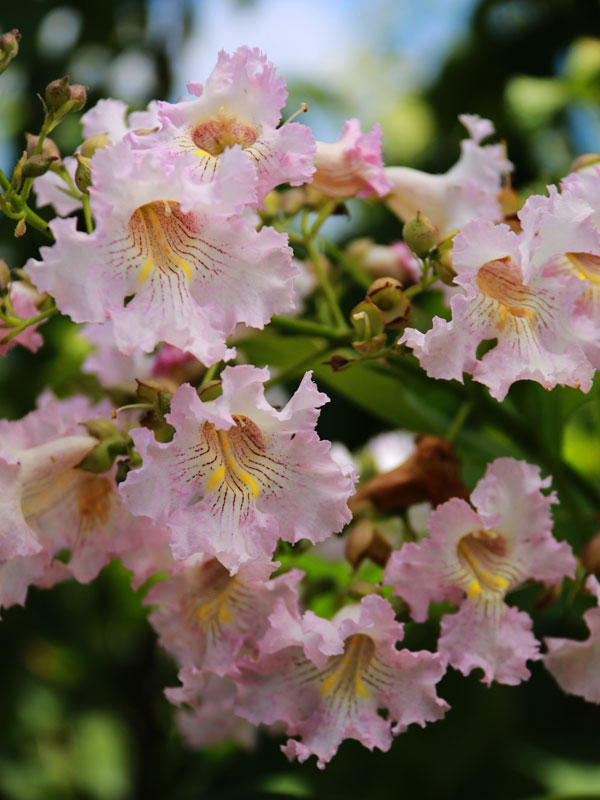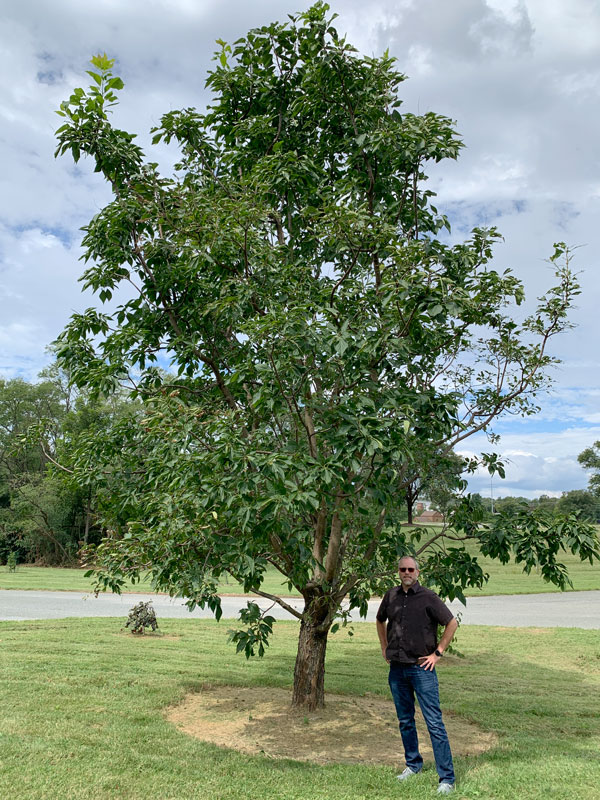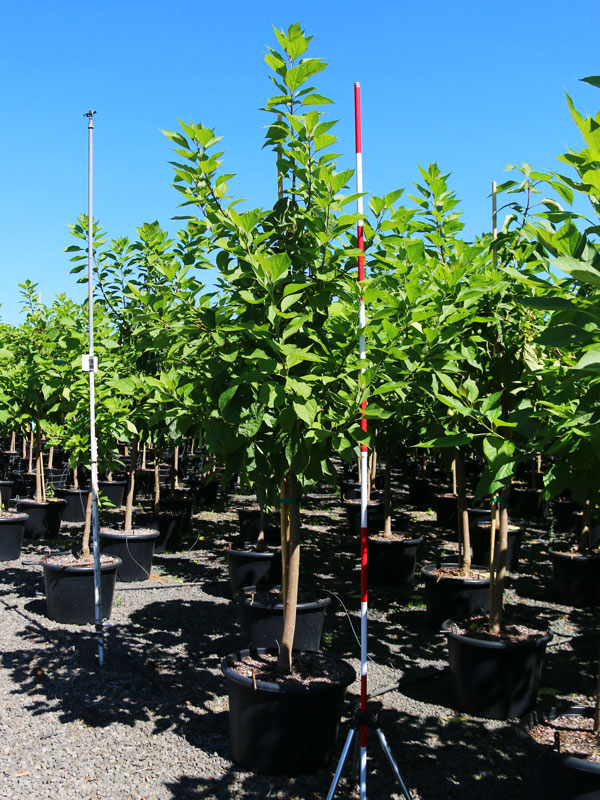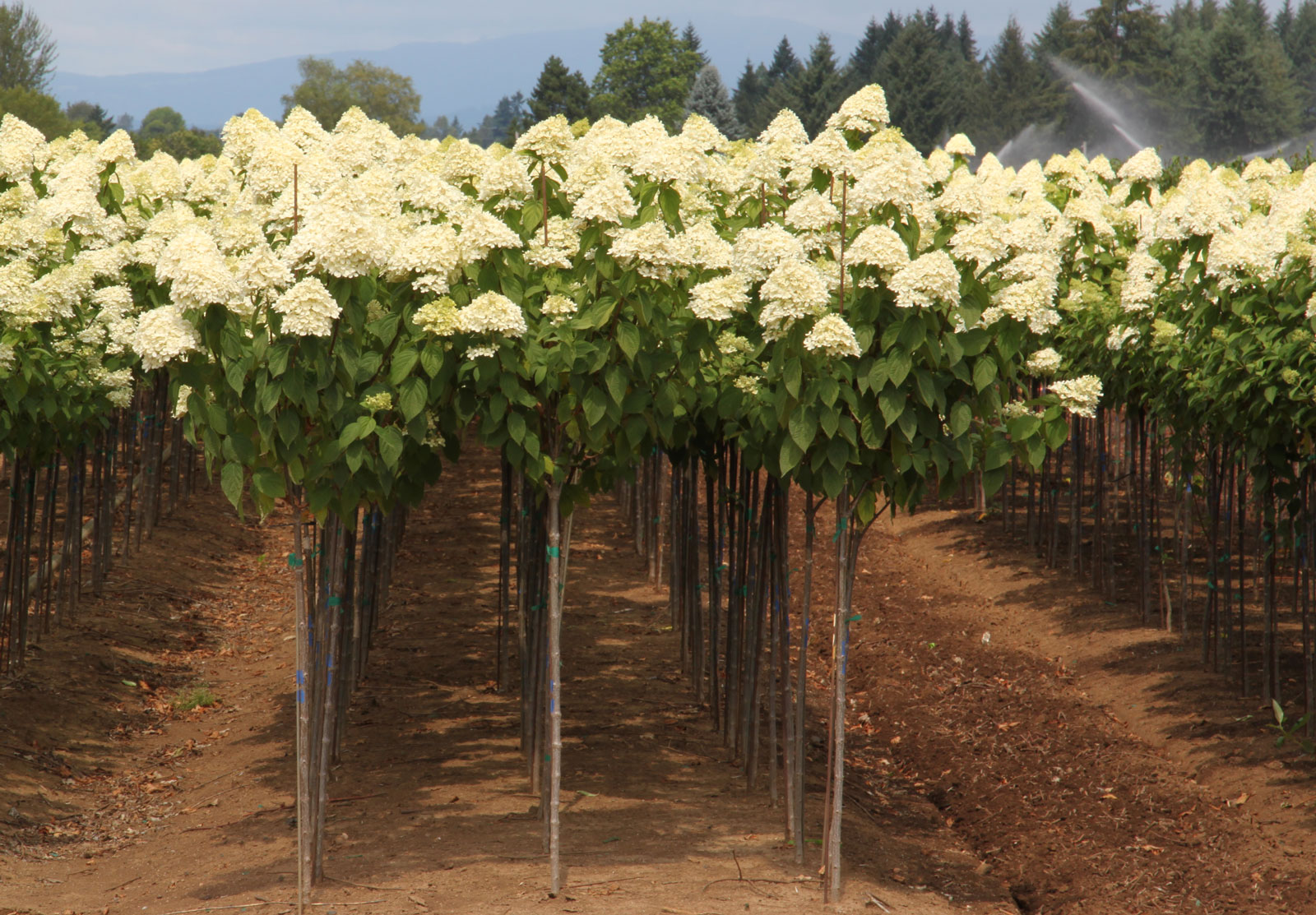Chi-what? There’s a new shade tree in town, and it’s a showstopper! Strawberry Moon Chitalpa turns heads when its large clusters of lavender-pink flowers bloom in June. Flowering continues through the summer months, with orchid-like blooms perched atop rounded, dark green leaves that cast cool shade. Foliage turns yellow in autumn and falls to reveal a handsome, upright, open branched winter silhouette.

Chitalpa tashkentensis ‘Strawberry Moon’ is a new release from the United States National Arboretum in Washington, D.C. It originated from controlled crosses made in 2008 between the tetraploid Chitalpa tashkentensis ‘Pink Dawn’ and Catalpa ovata, a diploid, yellow-flowering, powdery mildew tolerant species. The hybridization work was undertaken by Dr. Richard Olsen as part of his PhD studies at North Carolina State University. Upon completion of his PhD studies, he continued his efforts to develop an improved xChitalpa when hired as a geneticist at the U. S. National Arboretum. The most promising crosses were added to the Arboretum’s long-term test plots for continued observation. Dr. Olsen was appointed Director of the Arboretum in 2015.
Guy Meacham, JFS New Plant Development Manager, recalls the moment he first laid eyes on a particularly promising tree in the arboretum trial grounds.
“I first saw the tree that would be named Strawberry Moon back in 2016 when Dr. Richard Olsen took Keith Warren, Mike Dirr and I on a tour of the National Arboretum and the Beltsville trial grounds. We thought the tree had great potential then and asked if some scion wood could be sent to us for growing and production trials,” he said.
“The tree has performed very well for us, and we’re honored to be able to offer this remarkable new hybrid to the nursery trade,” he added. “It’s great to see this all come to fruition as a new National Arboretum introduction.”


The intergeneric triploid hybrid now known as Strawberry Moon Chitalpa combines the best traits of the North American native Desert Willow (Chilopsis linearis) and Catalpa species. Deeper pink flower color, improved resistance to powdery mildew, and improved tree form are superior traits that recommend it over its seed parent, Pink Dawn Chitalpa. The pollen parent, C. ovata, contributes qualities including brighter pink flowers, powdery mildew resistance, larger leaves and improved shade tree structure.
“This introduction wouldn’t have happened without an epiphany provided by other arboretum scientists,” Dr. Olsen related. “The idea of getting a better pink flower by crossing with the yellow-flowered Chinese Catalpa (C. ovata) was counterintuitive but brilliant.”
“This is a flowering tree with a tropical feel” according to a USNA fact sheet. In flower, its whorled panicles average 10 inches in length and support 30-50 flowers each. “Individual flowers have frilled lobes, with the lower lobe extending as a pollinator landing platform. Flower color appears pink with a pale yellow base and yellow-orange blotches.”
Compared to the commonly planted North American native species (Northern and Southern Catalpas), its triploid nature promises greatly reduced fruit set of the species’ long, slender, bean-like seed pods. This near-sterile feature, along with smaller foliage size, results in less litter and easier fall cleanup. Compared to our native species, ‘Strawberry Moon’ also develops a smaller, more rounded and open canopy as it matures to a height and spread of approximately 40’ x 35’.
True to its Desert Willow heritage, Strawberry Moon Chitalpa (once established) is tolerant of heat and drought. Currently rated hardy and best suited for growing in USDA Zones 6-8, further testing will determine whether it can be successfully grown across a wider range of hardiness zones.

Truly an arboreal citizen of the world, Strawberry Moon Chitalpa traces its origins back more than 60 years to Tashkent, Uzbekistan in the former Soviet Union. There, as described by Thomas Elias in Pacific Horticulture Magazine, Soviet geneticist Nikolia F. Rusanov made experimental crosses of four species of Catalpa with the Desert Willow. Few set fruit, but he was successful in crossing two North American native species: Catalpa bignonioides and Chilopsis linearis, both members of the Family Bignoniaceae. The exotic hybrids were tested in various regions of Central Asia and deemed successful ornamental landscape trees.
Fast forward to 1977, when Robert Hebb, horticulturist of the Cary Arboretum of the New York Botanical Garden, acquired cuttings of two hybrids during a Soviet/U.S. scientific exchange. He brought them back to the United States along with other “Soviet exotica”, according to the New York Times. In 1982, Hebb distributed cuttings to botanical gardens across the U.S for trial and introduction. These were named ‘Morning Cloud’ and ‘Pink Dawn’, with the latter proving to be quite successful in California, Arizona and in the Pacific Northwest where it is named a Great Plant Pick.
In 2015, propagation material of the tree that would become Strawberry Moon was distributed to trial sites in KY, MA, MD, NC, OR, PA, TN and TX. The unnamed tree performed so well in our own trials at JFS that we soon began to increase its numbers in anticipation of its future introduction by the U.S. National Arboretum. That day has arrived, with the official release of the Strawberry Moon Chitalpa having taken place in September 2023.
Additional reading:
Chitalpas, by Thomas Elias. Pacific Horticulture
Cary Arboretum Tests Soviet Exotica New York Times
Arboretum Profiles: Dr. Richard Olsen The National Bonsai Foundation
Gardeners! Please note that our nursery is strictly wholesale. To purchase trees grown by our nursery, please use our Retailer Locator to find sources of JFS trees near you.




